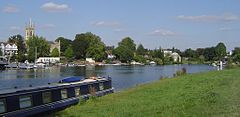- Moulsey Hurst
-
Coordinates: 51°24′36″N 0°21′40″W / 51.410°N 0.361°W
Moulsey Hurst cricket ground Location West Molesey, Surrey Home club Moulsey Hurst CC County club Surrey (pre-county club) Established by 1726 Last used 1806 Moulsey Hurst is located in what is now West Molesey, Surrey on the south bank of the River Thames above Molesey Lock. It is one of England's oldest sporting venues and was used in the 18th and 19th centuries for cricket, prizefighting and other sports.
The site can be reached from Hampton across the river by Hampton Ferry when it is running in the summer.
Contents
Sporting venue
When James VI and I became King of England in 1603, he brought his golf clubs with him and the first games of golf in England were played at Molesey, Westminster and Greenwich which were large open spaces adjacent to royal palaces.[1]
This venue is considered to be one of the birthplaces of cricket, along with other historical cricket greens, such as Mitcham Cricket Green. The earliest known use of the site for cricket was in 1726 and the first known first class cricket match to take place here was in 1733. One of cricket's most famous paintings is Cricket at Moulsey Hurst, by Richard Wilson in 1780. The painting is owned by MCC and on display at Lord's [2].
It was the site of the now defunct Hurst Park horse race course. The 1872 Ordnance Survey map shows a race course marked Molesey Hurst in this position. The location of the cricket ground was probably in the centre of the racecourse, which was common practice in the 18th century. It was at this ground where the now modern-day East Molesey CC began, although the current ground now lies (albeit still on the bank of the River Thames) on Graburn Way, about a quarter of a mile further east and a short walk from Hampton Court Palace.
Other sports and activities included ballooning, sprinting and archery.
Moulsey Hurst today
In 2004, Hurst Park Residents Association laid out a "heritage marker" close to the river, which contains a number of illustrations of the history and activities of the area [3].
Chronology of events
- 871 – Vikings sailed up the Thames here to sack Chertsey Abbey
- 1726 – the earliest known use of the site for cricket is recorded in the London Evening Post dated Sat 27 August 1726, in the paper's first year of publication; it carried an advertisement for a single wicket match [4]
- 1733 – earliest known use of the site for a first-class cricket match when Surrey played Middlesex
- May 1785 – James Sadler made a hot air balloon ascent near here, accompanied by a Member of Parliament, about a year after the success of the Montgolfier Brothers balloon
- Autumn 1787 – a professional runner named Powell ran a mile in 4 minutes and 3 seconds at Moulsey Hurst in preparation for an attempt on the 4 minute mile
- August 1795 – in a cricket match at Moulsey Hurst, John Tufton was dismissed leg before wicket (lbw) by John Wells; according to Arthur Haygarth [5] it was the first time lbw had ever been recorded in a scorecard
- 1798 – a Mr Troward, a member of the Toxophilite Society, shot an arrow on a level piece of ground on Moulsey Hurst seventeen score, or 340 yards
- 1806 – last known use of Moulsey Hurst for major cricket was the Surrey vs All England match.[6]
References
- ^ Malcolm Campbell, Glynn Satterly The Scottish Golf Book
- ^ David Underdown, Start of Play, Allen Lane, 2000 (the painting is illustrated in this book)
- ^ Peter Radford The Observer Sunday May 2, 2004
- ^ From Lads to Lord's
- ^ Scores & Biographies, Volume 1 (1744-1826), Lillywhite, 1862, page 191. Haygarth says: In this match, "leg before wicket" is found scored for the first time. In Britcher's printed score-book, Mr J. Tufton is in this match put down as bowled merely, and the leg before wicket added in a note. At first, when any one was got out in this way, it was marked down as simply bowled, and the leg before wicket omitted
- ^ Cricket Archive Surrey v All-England
External links
Further reading
- John Major, More Than A Game, HarperCollins, 2007
- David Underdown, Start of Play, Allen Lane, 2000
English first-class cricket venues to 1825 Aram's New Ground | Artillery Ground | Barrack Field | Bishopsbourne Paddock | Bowman's Lodge | Broadhalfpenny Down | Bromley Common | Burley-on-the-Hill
Caterham Common | Chislehurst Common | Cobham Park | Coxheath Common | Dandelion Paddock | Darnall New Ground | Darnall Old Ground
Dartford Brent | Datchet Common | Dripping Pan | Duppas Hill | Epsom Down | Forest New Ground | Guildford Bason | Holt Pound | Itchin Stoke Down
Kennington Common | Laleham Burway | Lamb's Conduit Field | Langton Park | Lord's Cricket Ground | Lord's Middle Ground | Lord's Old Ground
Mitcham Cricket Green | Moulsey Hurst | Napps | Navestock | Oldfield Bray | Perriam Down | Petworth Park | Prince of Wales Ground
Richmond Green | The Burys | Uxbridge Moor | Vine Cricket Ground | White Conduit Fields | Windmill DownCategories:- Cricket grounds in Surrey
- Boxing venues
- History of Surrey
- Parks and open spaces in Surrey
- English cricket in the 18th century
Wikimedia Foundation. 2010.

